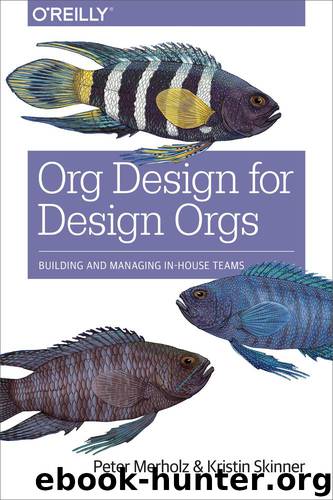Org Design for Design Orgs by Peter Merholz

Author:Peter Merholz
Language: eng
Format: epub
Tags: COMPUTERS / Web / Design
ISBN: 9781491938348
Publisher: O'Reilly Media
Published: 2016-08-22T00:00:00+00:00
Crafting the Job Posting
Many design managers deplore writing job postings. It’s not clear they actually work. They all sound the same with their repetitive template of introduction, responsibilities, and qualifications. They’re riddled with bullet points. The probable hire is someone who doesn’t match the description. Why bother?
Given the competitive market, it’s important to employ every available tool. At heart, the job posting serves a simple purpose: it is a signal of looking for talent. People considering new work discover a company has something to offer. Take the time to craft the job posting right. Avoid mindlessly following the template, and figure out how to communicate about the specific opportunity in a compelling way.
The biggest challenge for a job posting is the balance of general and specific. Too general, and people don’t know what the job is. Potentially great candidates won’t see themselves in the posting and won’t apply. Many who do apply could reasonably figure they are suitable, even when they are inappropriate. If the posting is too specific, potentially qualified candidates who don’t fit every bullet point may not bother.
The role descriptions from Chapter 5, which were biased toward generalism, are a good place to start. Add color to make the posting specific to what is sought. Call out the specific team (“Buyer Team,” “Seller Team”) and project work (“dashboards, analytics, and other tools for sellers”) that this role will be expected to deliver. State reasons why this is an interesting problem to solve.
When identifying responsibilities, be clear as to the type of work you expect the person will do. Will this person span from strategy to surface, or be able to focus on particular areas of the experience? Keep the focus on activities (conducting user research, designing structures, leading teams, coordinating across functions, crafting a new visual language, prototyping design solutions), and try to avoid discussing process documentation (personas, wireframes, mood boards, comps, etc.).
When articulating qualifications, focus on accomplishments and meaningful skills. Avoid numeric requirements like “5–7 years leading design teams,” in favor of “Demonstrated track record of leading design teams that have shipped quality software across web and mobile.” Instead of the uninspired and obvious “good presentation and communications skills,” try “can frame strong rationales for design decisions that persuade peers and executives.” Only mention tools (“Mastery of Adobe Creative Suite”) in junior or execution-specific roles; if listed in more senior roles, candidates may assume the company doesn’t take design seriously.
While the primary placement for job postings is the company’s website, they take on lives of their own on job-related sites like Indeed, LinkedIn, and Glassdoor. Make sure the posting contains context about the company, its mission, and its values.
Apply an iterative mindset to the creation and publication of a job posting. Gauge the response to the ad, and tweak it to attract more desirable candidates. Approximate A/B testing by trying different messages, emphases, and ordering. Until the job is filled, revisit the posting regularly.
Download
This site does not store any files on its server. We only index and link to content provided by other sites. Please contact the content providers to delete copyright contents if any and email us, we'll remove relevant links or contents immediately.
| Decorative Arts | Design History & Criticism |
| Furniture Design | Industrial & Product Design |
| Interior & Home Design | Jewelry Design |
| Textile & Costume |
POP by Steven Heller(2884)
Japanese Design by Patricia J. Graham(2556)
The Power of Broke by Daymond John(2376)
Architecture 101 by Nicole Bridge(2350)
Fusion 360 for Makers by Lydia Sloan Cline(1987)
Indistractable: How to Control Your Attention and Choose Your Life by Nir Eyal(1936)
Origami Art by Michael G. Lafosse & Richard L. Alexander(1735)
Actionable Gamification: Beyond Points, Badges, and Leaderboards by Yu-kai Chou(1723)
Batik by Rudolf Smend(1720)
Homebody by Joanna Gaines(1711)
Worn in New York by Emily Spivack(1619)
Feng Shui by Stephen Skinner(1616)
Whiskey in a Teacup by Reese Witherspoon(1577)
Austin Kleon by Steal Like an Artist(1537)
Don't Make Me Think, Revisited: A Common Sense Approach to Web Usability by Steve Krug(1528)
Simple Gatherings by Melissa Michaels(1512)
Hygge: The Danish Art of Happiness by Marie Tourell Søderberg(1428)
The Joy of Hygge by Jonny Jackson(1341)
The Laws of Simplicity by John Maeda(1300)
